A Trend Analysis of Leaf Area Index and Land Surface Temperature and Their Relationship from Global to Local Scale
Abstract
:1. Introduction
2. Data and Methodology
2.1. Data
2.2. Method
2.2.1. Data Pre-Processing
2.2.2. Change Detection Method
2.2.3. Statistical Analyses
Trend Analysis
Relationship between LAI and LST
3. Results
3.1. Global LAI and LST
3.1.1. Mean of LAI and LST for 2018
3.1.2. Change in Global LAI and LST during 2003 to 2018
3.2. Continental LAI and LST
3.2.1. Trends of Continental LAI
3.2.2. Trend of Continental LST
3.2.3. LAI and LST Continental Relationship
3.3. LAI and LST in the Most Greening Countries during 2003 to 2018
3.3.1. Trend of LAI and LST in China and India
3.3.2. Relationship between LAI and LST in China and India
3.3.3. Relationship between LAI and Air Temperature, Humidity and Precipitation in China and India
4. Discussion
5. Conclusions
- The current study highlights the spatial details of the changing global LAI and LST by mapping the spatial patterns of linear trends between two periods (2003–2010 and 2011–2018). Globally, the spatiotemporal variations in LAI between both periods demonstrate more positive trends than negative;
- The continental patterns of LAI and LST trends, and their linear relationships, indicated that LAI and LST varied by continent. In general, during the study period (2003–2018), all continents demonstrated a greening trend, with the most significant greening trend (trendp = 0.081) in Asia. The relationships between the LAI and LST in North America (R2 = 0.64 ***), Europe (R2 = 0.4 ***) and Asia (R2 = 0.64 ***) were very significant;
- We observed a significant greening trend for China and India, respectively (trendp = 0.16 *** and trendp = 0.13 ***), from 2003 to 2018. These results together confirmed the results presented by Chen et al. [22], despite a slight difference in the temporal observations of the satellite data product assessed by the two studies. Besides this, the study also found an insignificant LST trend for China (trendp = –0.13) and a weak negative trend for India (trendp = –0.69).
- An insignificant relationship between the LAI and LST in China (R2 = 0.057) is indicative of the impact of the positive greening trend on LAI. In contrast, a weak inverse relationship (R2 = 0.24) was observed for India and is attributed to a strong positive change in LAI in recent times, in this particular country, as observed in this study.
- A weak positive relationship between LAI and mean air temperature and specific humidity was observed in China. However, no relationship was found between LAI and selected climatic variables in India.
Author Contributions
Funding
Conflicts of Interest
Appendix A
| Year | Australia | Africa | N. America | C. America | S. America | Europe | Asia | Continental Average |
|---|---|---|---|---|---|---|---|---|
| 2003 | 0.664 | 1.213 | 0.779 | 2.257 | 2.350 | 0.960 | 1.105 | 1.333 |
| 2004 | 0.691 | 1.210 | 0.768 | 2.300 | 2.361 | 0.973 | 1.089 | 1.342 |
| 2005 | 0.673 | 1.205 | 0.801 | 2.223 | 2.369 | 1.009 | 1.104 | 1.341 |
| 2006 | 0.677 | 1.249 | 0.784 | 2.261 | 2.362 | 0.985 | 1.109 | 1.347 |
| 2007 | 0.664 | 1.227 | 0.785 | 2.314 | 2.354 | 1.024 | 1.117 | 1.355 |
| 2008 | 0.666 | 1.222 | 0.761 | 2.235 | 2.302 | 0.965 | 1.092 | 1.321 |
| 2009 | 0.666 | 1.236 | 0.751 | 2.300 | 2.356 | 0.988 | 1.114 | 1.344 |
| 2010 | 0.729 | 1.245 | 0.800 | 2.218 | 2.374 | 0.981 | 1.118 | 1.352 |
| 2011 | 0.762 | 1.235 | 0.769 | 2.245 | 2.356 | 1.055 | 1.122 | 1.363 |
| 2012 | 0.712 | 1.197 | 0.791 | 2.319 | 2.361 | 0.995 | 1.104 | 1.354 |
| 2013 | 0.684 | 1.234 | 0.782 | 2.203 | 2.354 | 1.035 | 1.140 | 1.347 |
| 2014 | 0.704 | 1.245 | 0.785 | 2.277 | 2.370 | 1.071 | 1.151 | 1.372 |
| 2015 | 0.695 | 1.234 | 0.814 | 2.292 | 2.426 | 1.064 | 1.168 | 1.385 |
| 2016 | 0.738 | 1.228 | 0.846 | 2.316 | 2.397 | 1.084 | 1.178 | 1.398 |
| 2017 | 0.742 | 1.249 | 0.828 | 2.311 | 2.392 | 1.020 | 1.152 | 1.385 |
| 2018 | 0.681 | 1.252 | 0.779 | 2.329 | 2.358 | 1.079 | 1.161 | 1.377 |
| Year | Australia | Africa | N. America | C. America | S. America | Europe | Asia | Continental Average |
|---|---|---|---|---|---|---|---|---|
| 2003 | 311.55 | 311.38 | 284.29 | 304.45 | 302.98 | 283.56 | 295.42 | 299.09 |
| 2004 | 311.00 | 311.30 | 283.13 | 303.77 | 302.82 | 283.28 | 295.57 | 298.69 |
| 2005 | 312.13 | 311.38 | 284.17 | 304.64 | 303.04 | 283.85 | 295.76 | 299.28 |
| 2006 | 310.91 | 311.07 | 284.71 | 304.08 | 302.72 | 283.34 | 295.41 | 298.89 |
| 2007 | 311.29 | 311.26 | 283.56 | 304.01 | 302.92 | 284.45 | 295.98 | 299.07 |
| 2008 | 310.93 | 311.01 | 283.05 | 304.11 | 302.99 | 283.89 | 295.71 | 298.81 |
| 2009 | 311.37 | 311.25 | 283.21 | 304.56 | 302.73 | 283.71 | 295.56 | 298.91 |
| 2010 | 309.13 | 311.60 | 284.43 | 303.96 | 303.20 | 283.25 | 295.64 | 298.74 |
| 2011 | 308.42 | 311.07 | 283.60 | 304.52 | 302.75 | 283.99 | 295.49 | 298.55 |
| 2012 | 310.20 | 311.01 | 284.86 | 303.88 | 303.15 | 283.80 | 295.46 | 298.91 |
| 2013 | 312.14 | 311.65 | 283.60 | 304.40 | 303.04 | 284.03 | 295.74 | 299.23 |
| 2014 | 311.56 | 311.39 | 283.80 | 303.86 | 302.88 | 284.41 | 295.85 | 299.11 |
| 2015 | 311.46 | 311.43 | 284.09 | 304.14 | 303.26 | 284.56 | 296.06 | 299.29 |
| 2016 | 310.73 | 311.93 | 284.88 | 304.39 | 303.46 | 284.34 | 296.04 | 299.39 |
| 2017 | 311.06 | 311.50 | 284.61 | 304.31 | 303.14 | 284.35 | 296.10 | 299.30 |
| 2018 | 312.00 | 311.21 | 283.68 | 303.96 | 302.91 | 284.50 | 295.82 | 299.15 |
| Year | LAI (China) | LST (China) | LAI (India) | LST (India) |
|---|---|---|---|---|
| 2003 | 0.80 | 293.09 | 0.91 | 307.46 |
| 2004 | 0.82 | 293.77 | 0.94 | 307.42 |
| 2005 | 0.79 | 293.12 | 0.94 | 307.53 |
| 2006 | 0.83 | 293.67 | 0.97 | 307.33 |
| 2007 | 0.84 | 293.92 | 0.97 | 307.26 |
| 2008 | 0.85 | 293.41 | 0.96 | 306.85 |
| 2009 | 0.85 | 293.50 | 0.96 | 307.84 |
| 2010 | 0.81 | 292.94 | 0.96 | 307.13 |
| 2011 | 0.86 | 293.03 | 1.01 | 306.77 |
| 2012 | 0.84 | 292.47 | 0.96 | 306.98 |
| 2013 | 0.92 | 293.49 | 1.01 | 306.74 |
| 2014 | 0.89 | 293.48 | 1.04 | 306.72 |
| 2015 | 0.90 | 293.72 | 1.06 | 306.79 |
| 2016 | 0.93 | 293.34 | 1.00 | 307.72 |
| 2017 | 0.95 | 293.56 | 1.07 | 307.20 |
| 2018 | 0.93 | 293.28 | 1.01 | 307.08 |
References
- Asner, G.P.; Martin, R.E. Airborne spectranomics: Mapping canopy chemical and taxonomic diversity in tropical forests. Front. Ecol. Environ. 2009, 7, 269–276. [Google Scholar] [CrossRef] [Green Version]
- Deng, F.; Chen, J.M.; Plummer, S.; Chen, M.; Pisek, J. Algorithm for global leaf area index retrieval using satellite imagery. IEEE Trans. Geosci. Remote Sens. 2006, 44, 2219–2229. [Google Scholar] [CrossRef] [Green Version]
- Xiao, Z.; Liang, S.; Wang, J.; Xiang, Y.; Zhao, X.; Song, J. Long-time-series global land surface satellite leaf area index product derived from MODIS and AVHRR surface reflectance. IEEE Trans. Geosci. Remote Sens. 2016, 54, 5301–5318. [Google Scholar] [CrossRef]
- Liu, Y.; Liu, R.; Chen, J.M. Retrospective retrieval of long-term consistent global leaf area index (1981–2011) from combined AVHRR and MODIS data. J. Geophys. Res. Biogeosci. 2012, 117. [Google Scholar] [CrossRef]
- Zhu, Z.; Bi, J.; Pan, Y.; Ganguly, S.; Anav, A.; Xu, L.; Samanta, A.; Piao, S.; Nemani, R.R.; Myneni, R.B. Global data sets of vegetation leaf area index (LAI) 3g and fraction of photosynthetically active radiation (FPAR) 3g derived from global inventory modeling and mapping studies (GIMMS) normalized difference vegetation index (NDVI3g) for the period 1981 to 2011. Remote Sens. 2013, 5, 927–948. [Google Scholar]
- Tum, M.; Günther, K.P.; Böttcher, M.; Baret, F.; Bittner, M.; Brockmann, C.; Weiss, M. Global gap-free MERIS LAI time series (2002–2012). Remote Sens. 2016, 8, 69. [Google Scholar] [CrossRef] [Green Version]
- Shabanov, N.V.; Huang, D.; Yang, W.; Tan, B.; Knyazikhin, Y.; Myneni, R.B.; Ahl, D.E.; Gower, S.T.; Huete, A.R.; Aragão, L.E.O. Analysis and optimization of the MODIS leaf area index algorithm retrievals over broadleaf forests. IEEE Trans. Geosci. Remote Sens. 2005, 43, 1855–1865. [Google Scholar] [CrossRef] [Green Version]
- Yan, K.; Park, T.; Yan, G.; Chen, C.; Yang, B.; Liu, Z.; Nemani, R.R.; Knyazikhin, Y.; Myneni, R.B. Evaluation of MODIS LAI/FPAR product collection 6. Part 1: Consistency and improvements. Remote Sens. 2016, 8, 359. [Google Scholar] [CrossRef] [Green Version]
- Buermann, W.; Dong, J.; Zeng, X.; Myneni, R.B.; Dickinson, R.E. Evaluation of the utility of satellite-based vegetation leaf area index data for climate simulations. J. Clim. 2001, 14, 3536–3550. [Google Scholar] [CrossRef]
- Myneni, R.B.; Yang, W.; Nemani, R.R.; Huete, A.R.; Dickinson, R.E.; Knyazikhin, Y.; Didan, K.; Fu, R.; Juárez, R.I.N.; Saatchi, S.S. Large seasonal swings in leaf area of Amazon rainforests. Proc. Natl. Acad. Sci. USA 2007, 104, 4820–4823. [Google Scholar] [CrossRef] [Green Version]
- Piao, S.; Yin, G.; Tan, J.; Cheng, L.; Huang, M.; Li, Y.; Liu, R.; Mao, J.; Myneni, R.B.; Peng, S. Detection and attribution of vegetation greening trend in China over the last 30 years. Glob. Chang. Biol. 2015, 21, 1601–1609. [Google Scholar] [CrossRef] [PubMed]
- Zhu, Z.; Piao, S.; Myneni, R.B.; Huang, M.; Zeng, Z.; Canadell, J.G.; Ciais, P.; Sitch, S.; Friedlingstein, P.; Arneth, A.; et al. Greening of the Earth and its drivers. Nat. Clim. Chang. 2016, 6, 791–795. [Google Scholar] [CrossRef]
- Chen, J.M.; Black, T.A. Defining leaf area index for non-flat leaves. Plant Cell Environ. 1992, 15, 421–429. [Google Scholar] [CrossRef]
- Global Climate Observing System. Available online: https://public.wmo.int/en/programmes/global-climate-observing-system (accessed on 27 August 2020).
- Yan, H.; Wang, S.Q.; Billesbach, D.; Oechel, W.; Zhang, J.H.; Meyers, T.; Martin, T.A.; Matamala, R.; Baldocchi, D.; Bohrer, G. Global estimation of evapotranspiration using a leaf area index-based surface energy and water balance model. Remote Sens. Environ. 2012, 124, 581–595. [Google Scholar] [CrossRef] [Green Version]
- Gower, S.T.; Kucharik, C.J.; Norman, J.M. Direct and indirect estimation of leaf area index, fAPAR, and net primary production of terrestrial ecosystems. Remote Sens. Environ. 1999, 70, 29–51. [Google Scholar] [CrossRef]
- Jonckheere, I.; Fleck, S.; Nackaerts, K.; Muys, B.; Coppin, P.; Weiss, M.; Baret, F. Review of methods for in situ leaf area index determination: Part I. Theories, sensors and hemispherical photography. Agric. For. Meteorol. 2004, 121, 19–35. [Google Scholar] [CrossRef]
- Asner, G.P.; Scurlock, J.M.; Hicke, J.A. Global synthesis of leaf area index observations: Implications for ecological and remote sensing studies. Glob. Ecol. Biogeogr. 2003, 12, 191–205. [Google Scholar] [CrossRef] [Green Version]
- Turner, D.P.; Cohen, W.B.; Kennedy, R.E.; Fassnacht, K.S.; Briggs, J.M. Relationships between leaf area index, fapar, and net primary production of terrestrial ecosystems. Remote Sens. Environ. 1999, 70, 52–68. [Google Scholar] [CrossRef]
- Munier, S.; Carrer, D.; Planque, C.; Camacho, F.; Albergel, C.; Calvet, J.-C. Satellite Leaf Area Index: Global scale analysis of the tendencies per vegetation type over the last 17 years. Remote Sens. 2018, 10, 424. [Google Scholar] [CrossRef] [Green Version]
- Pan, N.; Feng, X.; Fu, B.; Wang, S.; Ji, F.; Pan, S. Increasing global vegetation browning hidden in overall vegetation greening: Insights from time-varying trends. Remote Sens. Environ. 2018, 214, 59–72. [Google Scholar] [CrossRef]
- Chen, C.; Park, T.; Wang, X.; Piao, S.; Xu, B.; Chaturvedi, R.K.; Fuchs, R.; Brovkin, V.; Ciais, P.; Fensholt, R. China and India lead in greening of the world through land-use management. Nat. Sustain. 2019, 2, 122–129. [Google Scholar] [CrossRef] [PubMed]
- Huang, M.; Piao, S.; Ciais, P.; Peñuelas, J.; Wang, X.; Keenan, T.F.; Peng, S.; Berry, J.A.; Wang, K.; Mao, J. Air temperature optima of vegetation productivity across global biomes. Nat. Ecol. Evol. 2019, 3, 772–779. [Google Scholar] [CrossRef]
- Peñuelas, J.; Filella, I. Phenology feedbacks on climate change. Science 2009, 324, 887–888. [Google Scholar] [CrossRef] [PubMed] [Green Version]
- Richardson, A.D.; Keenan, T.F.; Migliavacca, M.; Ryu, Y.; Sonnentag, O.; Toomey, M. Climate change, phenology, and phenological control of vegetation feedbacks to the climate system. Agric. For. Meteorol. 2013, 169, 156–173. [Google Scholar] [CrossRef]
- Cowles, J.; Boldgiv, B.; Liancourt, P.; Petraitis, P.S.; Casper, B.B. Effects of increased temperature on plant communities depend on landscape location and precipitation. Ecol. Evol. 2018, 8, 5267–5278. [Google Scholar] [CrossRef] [PubMed]
- Peng, S.-S.; Piao, S.; Zeng, Z.; Ciais, P.; Zhou, L.; Li, L.Z.; Myneni, R.B.; Yin, Y.; Zeng, H. Afforestation in China cools local land surface temperature. Proc. Natl. Acad. Sci. USA 2014, 111, 2915–2919. [Google Scholar] [CrossRef] [Green Version]
- Tao, F.; Chen, Y.; Fu, B. Impacts of climate and vegetation leaf area index changes on global terrestrial water storage from 2002 to 2016. Sci. Total Environ. 2020, 724, 138298. [Google Scholar] [CrossRef]
- modis.gsfc.nasa.gov MODIS. Available online: https://modis.gsfc.nasa.gov/about/ (accessed on 12 September 2020).
- Wan, Z.; Hook, S.; Hulley, G. MYD11A2 MODIS/Aqua Land Surface Temperature/Emissivity 8-Day L3 Global 1km SIN Grid V006. Available online: https://doi.org/10.5067/MODIS/MYD11A2.006 (accessed on 12 September 2020).
- Myneni, Y.K.R. MCD15A3H MODIS/Terra+Aqua Leaf Area Index/FPAR 4-day L4 Global 500m SIN Grid V006; LP DAAC: Sioux Falls, SD, USA, 2015. [Google Scholar] [CrossRef]
- Saha, S.; Moorthi, S.; Wu, X.; Wang, J.; Nadiga, S.; Tripp, P.; Behringer, D.; Hou, Y.T.; Chuang, H.-Y.; Iredell, M. NCEP climate forecast system version 2 (CFSv2) 6-hourly products. In Research Data Archive at the National Center for Atmospheric Research, Computational and Information Systems Laboratory; NCEP: Boulder, CO, USA, 2011. [Google Scholar] [CrossRef]
- ECMWF. Copernicus Climate Change Service (C3S) ERA5: Fifth generation of ECMWF atmospheric reanalyses of the global climate. In Copernicus Climate Change Service Climate Data Store (CDS); ECMWF: Reading, UK, 2017. [Google Scholar]
- Gorelick, N.; Hancher, M.; Dixon, M.; Ilyushchenko, S.; Thau, D.; Moore, R. Google Earth Engine: Planetary-scale geospatial analysis for everyone. Remote Sens. Environ. 2017, 202, 18–27. [Google Scholar] [CrossRef]
- Team, R.C. R: A Language And Environment for Statistical Computing; The R Foundation for Statistical Computing: Vienna, Austria, 2020. [Google Scholar]
- Wickham, H.; Francois, R.; Henry, L.; Müller, K. dplyr: A Grammar of Data Manipulation. R package version 0.4. 3. The R Foundation for Statistical Computing, Vienna. 2015. Available online: https://CRAN.R-project.org/package=dplyr (accessed on 12 October 2020).
- Wickham, H. The Tidyverse. R package ver. 2017. Available online: https://slides.nyhackr.org/presentations/The-Tidyverse_Hadley-Wickham.pdf (accessed on 12 October 2020).
- Kassambara, A. Package “ggpubr”.’ggplot2’ Based Publication Ready Plots Version. 2020. Available online: https://CRAN.R-project.org/package=clinfun (accessed on 12 October 2020).
- Wickham, H.; Chang, W.; Wickham, M.H. Package ‘ggplot2.’ Create Elegant Data Visualisations Using the Grammar of Graphics Version. 2020. Available online: https://ggplot2.tidyverse.org/reference/ggplot2-package.html (accessed on 12 October 2020).
- Bronaugh, D.; Werner, A.; Bronaugh, M.D. Package ‘zyp.’ CRAN Repository. 2009. Available online: https://cran.biodisk.org/web/packages/zyp/zyp.pdf (accessed on 12 October 2020).
- Carslaw, D.C. Section 15 Theil-Sen Trends | The Openair Book. Available online: https://bookdown.org/david_carslaw/openair/sec-TheilSen.html (accessed on 12 October 2020).
- Yue, S.; Pilon, P.; Cavadias, G. Power of the Mann–Kendall and Spearman’s rho tests for detecting monotonic trends in hydrological series. J. Hydrol. 2002, 259, 254–271. [Google Scholar] [CrossRef]
- Yan, K.; Park, T.; Chen, C.; Xu, B.; Song, W.; Yang, B.; Zeng, Y.; Liu, Z.; Yan, G.; Knyazikhin, Y. Generating global products of lai and fpar from snpp-viirs data: Theoretical background and implementation. IEEE Trans. Geosci. Remote Sens. 2018, 56, 2119–2137. [Google Scholar] [CrossRef]
- Jiang, C.; Ryu, Y.; Fang, H.; Myneni, R.; Claverie, M.; Zhu, Z. Inconsistencies of interannual variability and trends in long-term satellite leaf area index products. Glob. Chang. Biol. 2017, 23, 4133–4146. [Google Scholar] [CrossRef] [PubMed]
- Valentini, R.; Arneth, A.; Bombelli, A.; Castaldi, S.; Cazzolla Gatti, R.; Chevallier, F.; Ciais, P.; Grieco, E.; Hartmann, J.; Henry, M. A full greenhouse gases budget of Africa: Synthesis, uncertainties, and vulnerabilities. Biogeosciences 2014, 11, 381–407. [Google Scholar] [CrossRef] [Green Version]
- Bombelli, A.; Henry, M.; Castaldi, S.; Adu-Bredu, S.; Arneth, A.; De Grandcourt, A.; Grieco, E.; Kutsch, W.L.; Lehsten, V.; Rasile, A. An outlook on the Sub-Saharan Africa carbon balance. Biogeosciences 2009, 6, 2193–2205. [Google Scholar] [CrossRef] [Green Version]
- Jiao, T.; Williams, C.A.; Rogan, J.; De Kauwe, M.G.; Medlyn, B.E. Drought impacts on australian vegetation during the millennium drought measured with multisource spaceborne remote sensing. J. Geophys. Res. Biogeosciences 2020, 125, e2019JG005145. [Google Scholar] [CrossRef]
- Wardlaw, I.F. Temperature control of translocation. In Mechanism of Regulation of Plant Growth; Bielske, R.L., Ferguson, A.R., Cresswell, M.M., Eds.; Bull. Royal Soc.: Wellington, New Zealand, 1974; pp. 533–538. [Google Scholar]
- Abrol, Y.P.; Ingram, K.T. Effects of higher day and night temperatures on growth and yields of some crop plants. In Global Climate Change and Agricultural Production: Direct and Indirect Effects of Changing Hydrological, Pedological and Plant Physiological Processes; Wiley: Chichester, UK, 1996; pp. 124–140. [Google Scholar]
- Yu, L.; Liu, Y.; Liu, T.; Yan, F. Impact of recent vegetation greening on temperature and precipitation over China. Agric. For. Meteorol. 2020, 295, 108197. [Google Scholar] [CrossRef]
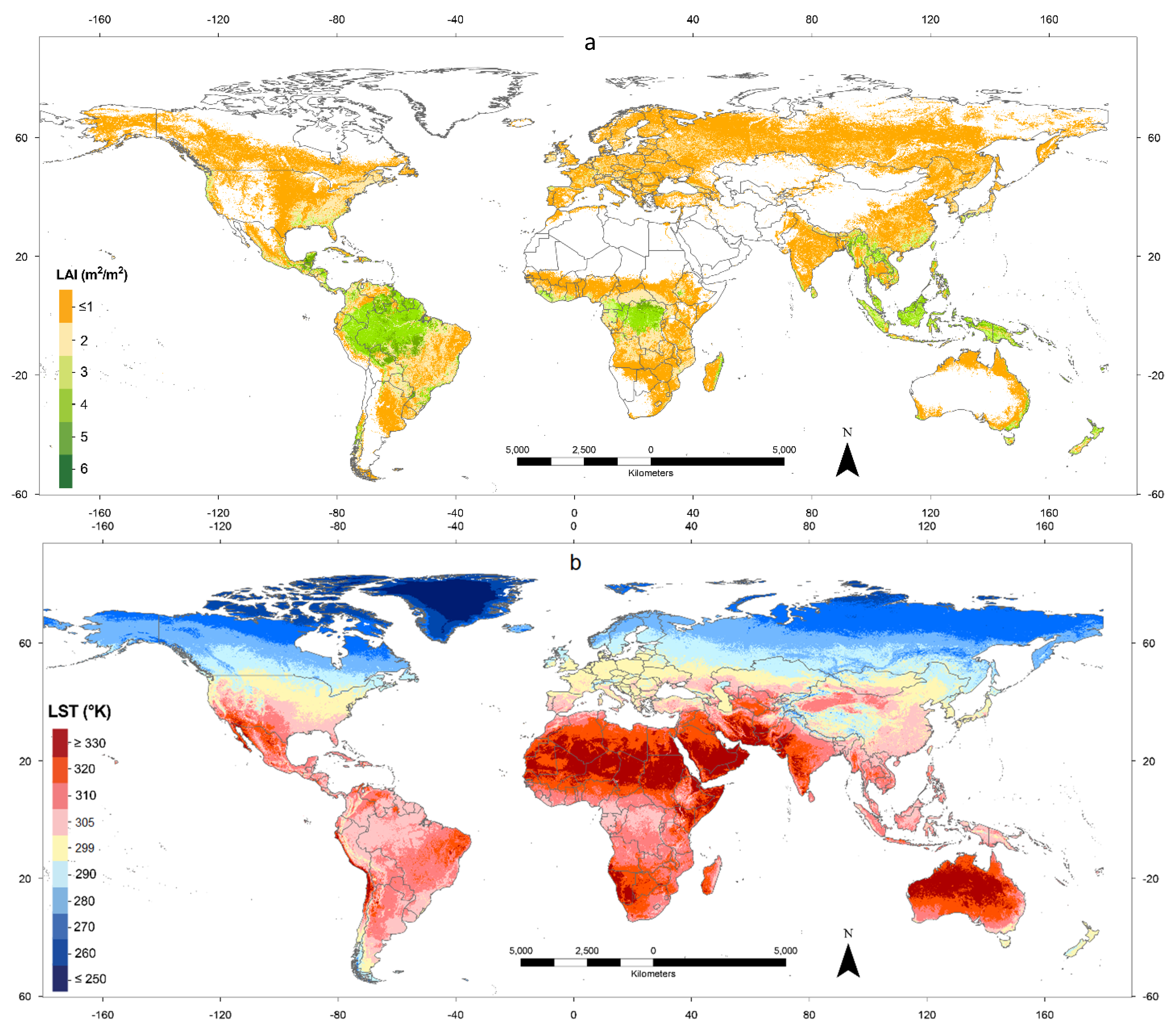
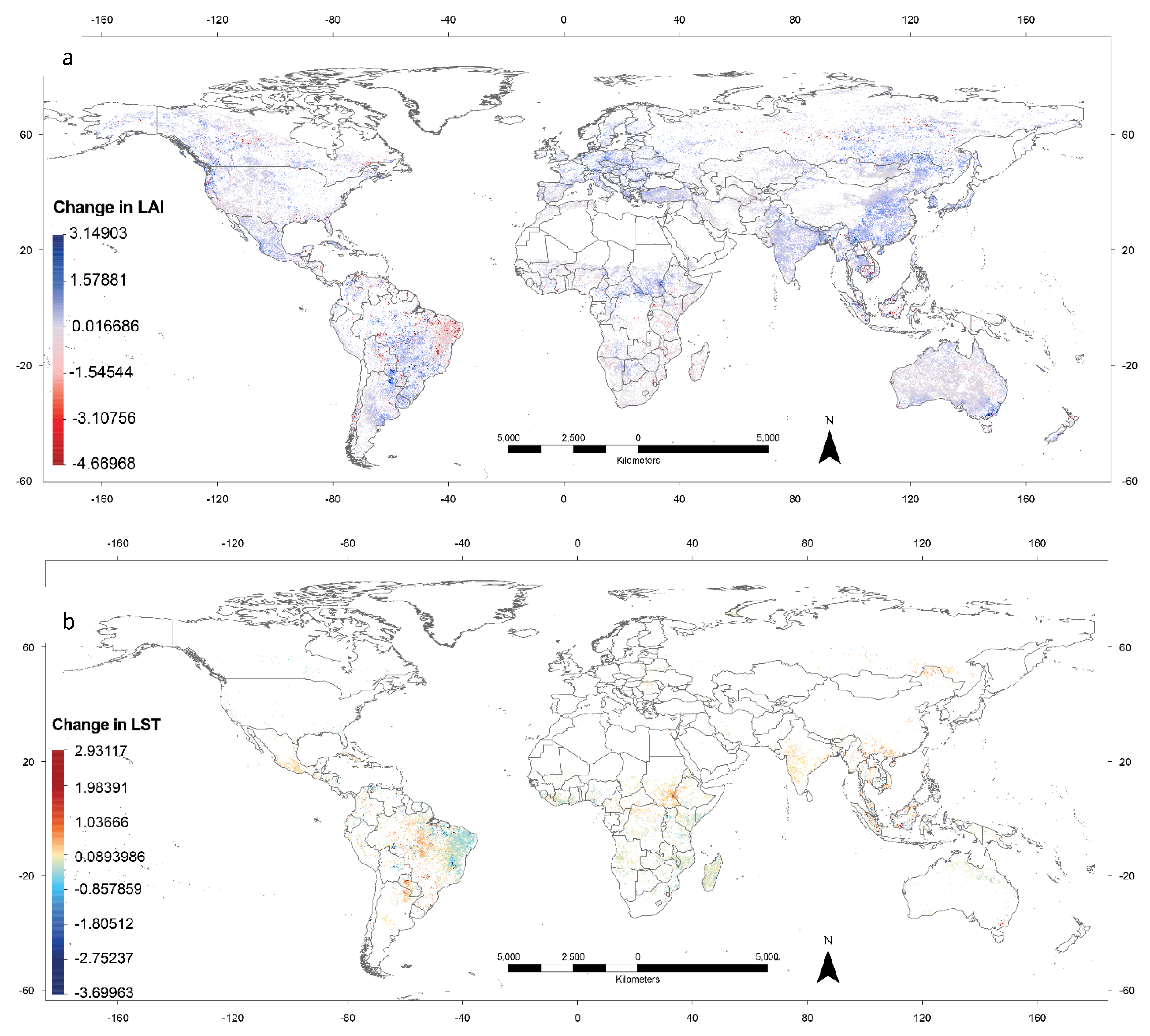

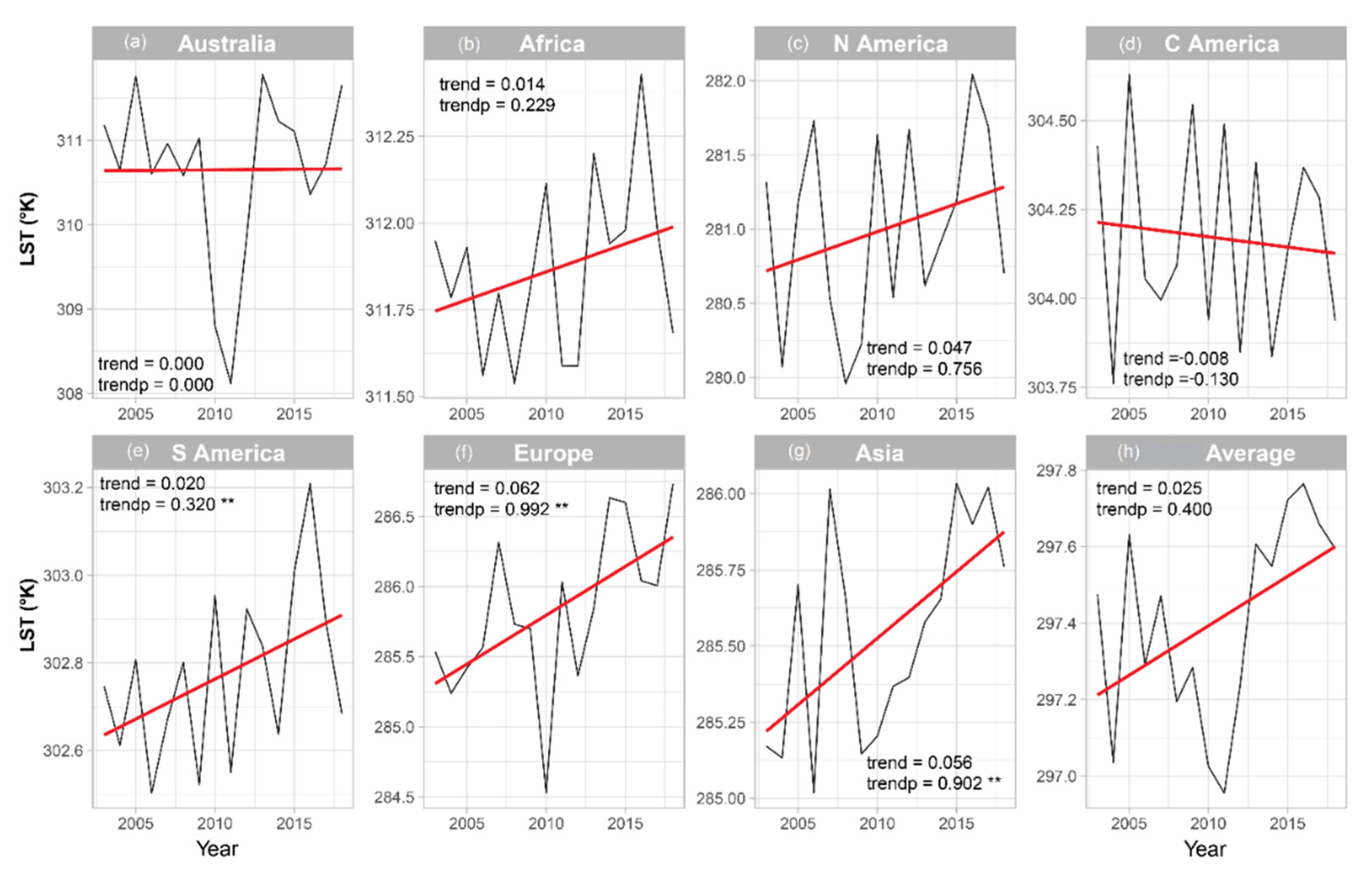
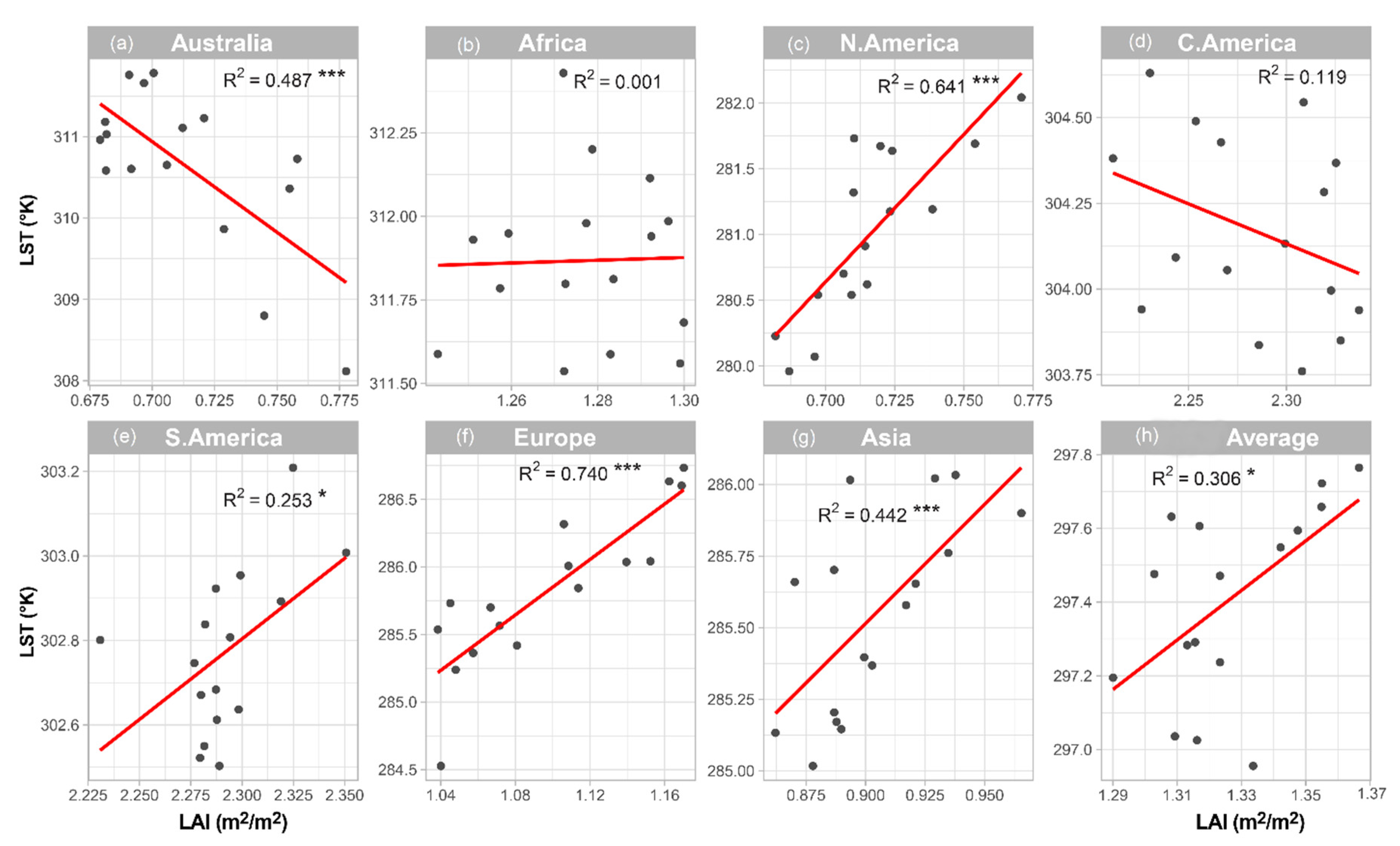
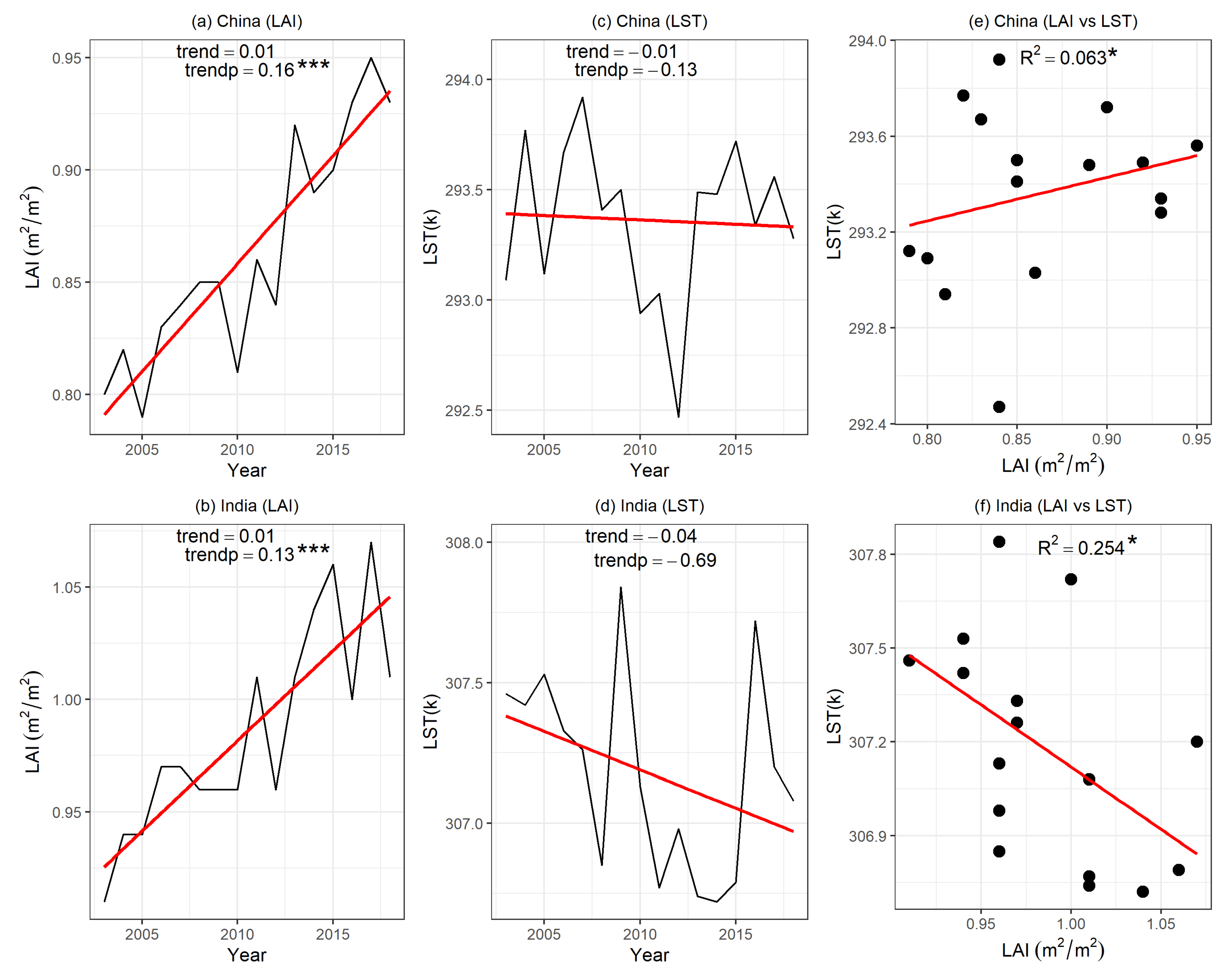

| Data | Temporal Resolution | Spatial Resolution | Data ID in GEE | Selected Band |
|---|---|---|---|---|
| Daytime Land Surface Temperature (Aqua) | 8 days | 1 km | MODIS/006/MYD11A2 | LST_Day_1km |
| Leaf Area Index | 4 days | 500 m | MODIS/006/MCD15A3H | Lai |
| Air temperature | Monthly | 0.25 arc degrees | ECMWF/ERA5/MONTHLY | mean_2m_air_temperature |
| Total precipitation | Monthly | 0.25 arc degrees | ECMWF/ERA5/MONTHLY | total_precipitation |
| Specific humidity | Four times per day | 0.2 arc degrees | NOAA/CFSV2/FOR6H | Specific_humidity_height_above_ground |
© 2020 by the authors. Licensee MDPI, Basel, Switzerland. This article is an open access article distributed under the terms and conditions of the Creative Commons Attribution (CC BY) license (http://creativecommons.org/licenses/by/4.0/).
Share and Cite
Rasul, A.; Ibrahim, S.; Onojeghuo, A.R.; Balzter, H. A Trend Analysis of Leaf Area Index and Land Surface Temperature and Their Relationship from Global to Local Scale. Land 2020, 9, 388. https://doi.org/10.3390/land9100388
Rasul A, Ibrahim S, Onojeghuo AR, Balzter H. A Trend Analysis of Leaf Area Index and Land Surface Temperature and Their Relationship from Global to Local Scale. Land. 2020; 9(10):388. https://doi.org/10.3390/land9100388
Chicago/Turabian StyleRasul, Azad, Sa’ad Ibrahim, Ajoke R. Onojeghuo, and Heiko Balzter. 2020. "A Trend Analysis of Leaf Area Index and Land Surface Temperature and Their Relationship from Global to Local Scale" Land 9, no. 10: 388. https://doi.org/10.3390/land9100388







